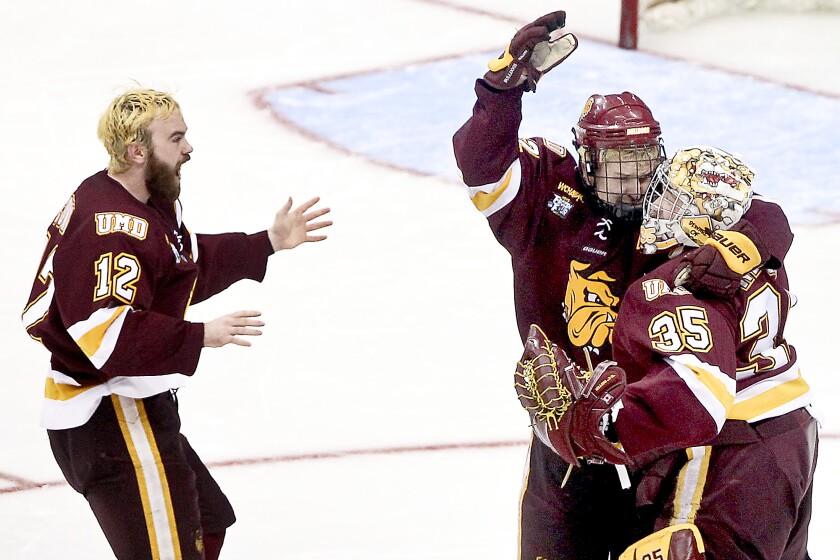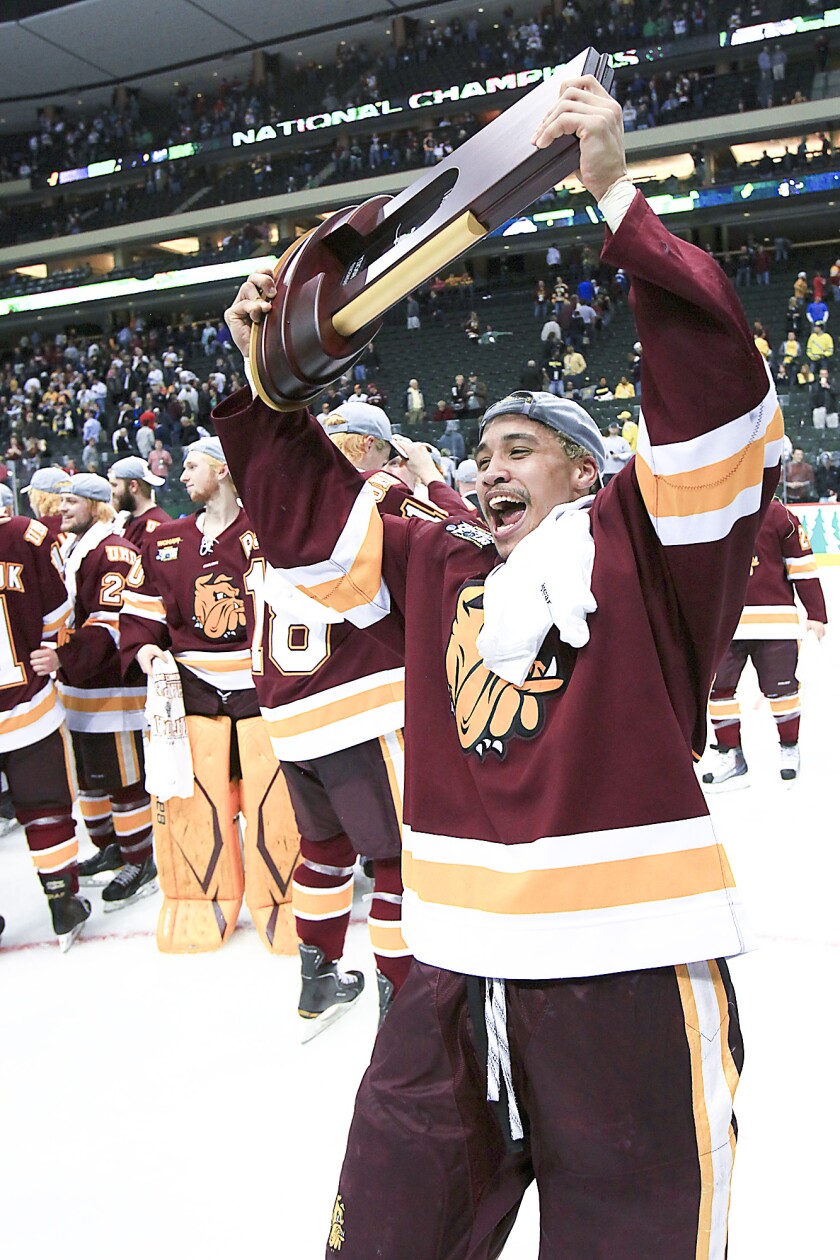DULUTH — “Trying to find somebody in front, centered, SCOOOOOOOORE...KYLE SCHMIDT, MINNESOTA DULUTH, their first title!”
A decade later, those words from ESPN play-by-play man Gary Thorne still echo in the minds of college hockey fans everywhere between Grand Rapids and Grand Portage. The night of April 9, 2011 is not an official holiday in the Twin Ports, but the memories of that evening, and the overtime heroics that brought the first NCAA men’s hockey title to the UMD campus, are recalled every year about this time.
With the Bulldogs headed back to the Frozen Four — their fourth in a row — and looking for a nearly unprecedented third-consecutive national title in Pittsburgh, it is easy to get caught up in the idea that UMD is and has always been a powerhouse on the college hockey scene. But a decade ago, many of their 2020-21 Bulldogs were still being handed a coloring placemat and crayons, and ordering off the kids’ menu when eating out with their parents. With that in mind, it is worth taking a look at all that has changed in the on-ice prowess and the off-ice perception of the Bulldogs in the 519 weeks since Schmidt took a pass from Travis Oleksuk, caught Michigan goalie Shawn Hunwick leaning the wrong way, and snapped a quick shot into the Wolverines net, setting off a celebration all across the State of Hockey.
ADVERTISEMENT
When you watch the 2011 video today, you will note that the Michigan Wolverines are gassed. They had iced the puck a few times in a fruitless attempt to get fresh troops on the ice and could not. The Bulldogs were fresh and energized. Schmidt noted that when he passed the puck behind the net, then curled to the goalmouth, Wolverines forward Ben Winnett couldn’t really keep up, and Schmidt was mostly undefended in front of Hunwick.
It's #FrozenFour week!
— UMD Athletics (@UMDBulldogs) April 5, 2021
Lets kick it off with a look back at when @UMDMensHockey brought home their first title in front of their home state 🏆 pic.twitter.com/Kx9muouyZc
“Everything is a stinking blur, to be honest, so the only reason I remember anything is because there’s video proof of it,” Schmidt said. “Even in the ESPN feed, you can hear me scream ‘T.O!’ and (Oleksuk) doesn’t even look, he just passes it to where my voice was, and it was just perfect, right on my tape.”
Today much is made about the fact that the Bulldogs are headed to their fourth consecutive Frozen Four in 2021, after their marathon five-overtime victory over North Dakota in the regional final. In 2011 they beat Union and Yale to get to the Frozen Four in St. Paul, and it was just the fourth such trip in school history at the time.
“It just wasn’t a regular thing back when we were in school,” said Schmidt, who lives in Esko, Minn., and works for Minnesota Power. “Now it’s like, ‘Where’s the Frozen Four this year, let’s grab tickets.’ It’s crazy how it’s just expected. That’s when you kind of know we’ve arrived on the national scene, at least for a time. The expectation is we’re going to the Frozen Four and we’re going to try to win a national title. And we go to the Frozen Four every stinking year, it seems like.”
Mike Sertich had led the Bulldogs on back-to-back trips to Lake Placid and Detroit, respectively, in 1984 and 1985, and Scott Sandelin’s fourth season as coach of the Bulldogs, in 2004, ended with a Frozen Four semifinal loss to eventual champion Denver in Boston. There was a perception then that the Bulldogs were a program on the rise, and would be an every-year NCAA tournament entrant.
ADVERTISEMENT

Instead, the program sunk back to mediocrity, finishing under .500 and on the lower rungs of the WCHA for the next four years. By March of 2009, after a seventh-place finish in the conference, there was a widely-circulated rumor that Sandelin would be dismissed at season’s end and the program would start over. Schmidt, a sophomore on that team, said there was a definite perception in the locker room that their coach’s job was on the line.
So the Bulldogs went on the road and upset Colorado College in the opening round of the WCHA playoffs, then came to St. Paul for the WCHA Final Five needing to win three games in three nights — something that had not been done before in the league tournament — to get to the NCAAs. Over the next 72 hours, fans at Xcel Energy Center witnessed the Alex Stalock Show, as the Bulldogs goalie, playing 10 minutes from his hometown of South St. Paul, allowed one goal over the next 180 minutes of hockey and the Bulldogs won the Final Five, grabbing the NCAA tourney auto-bid that comes with it.
A week later in the regional round, we saw the Miracle at Mariucci , when the Bulldogs trailed Princeton by two goals with 40 seconds remaining, then rallied for an overtime win. The fairytale ended a day later, with a loss to Miami in the regional final, but there was a perception that the Bulldogs were again headed in the right direction.
Since the 2011 title, the Bulldogs have missed the NCAA tournament just twice (in 2013 and 2014) and are now considered one of the perennial national title contenders. Their first title came after a decade, the 2000s, where the tournament was dominated by the traditional blue-blood programs in the game. Between 2000 and 2009, the national titles were won by North Dakota, Boston College (twice), Minnesota (twice), Denver (twice), Wisconsin, Michigan State and Boston University.

By contrast, we saw plenty of “new blood” in the next 10 years starting perhaps with Bemidji State and Miami making the 2009 Frozen Four. In 2010, RIT was the first-timer. After the Bulldogs’ 2011 title, Ferris State went to the 2012 title game. In 2013, it was Yale beating Quinnipiac for the championship, after first-timers UMass-Lowell and St. Cloud State also made the Frozen Four. In 2014, it was Union knocking off powerful Minnesota for the first title by the Dutchmen. A year later Providence rallied to upset Boston University in Boston for the Friars’ first NCAA hockey crown.
ADVERTISEMENT
The Bulldogs dominated the latter years of the 2010s, falling to Denver in the 2017 title game, holding off Notre Dame in 2018 to claim UMD’s second crown, and not really ever letting UMass have any hope in a dominating 3-0 win for the 2019 crown. The Bulldogs were making a late-season push in 2020 and looked very much like a three-peat contender then, when college hockey was shut down due to the pandemic.
“It’s amazing to see how far it’s come. Quintessentially, I think we’re the model program for college hockey,” said Kenny Reiter, the goalie who backstopped that 2011 title. “I did not have the foresight back then to see that, but it’s a testament to the personnel and the players they brought in.”
Reiter lives back in his native Pittsburgh now, working in sales for Ferguson Waterworks. He joked that it’s nice of the Bulldogs to play the last two Frozen Fours in Buffalo, three hours away, and in Pittsburgh, just minutes from his home. Reiter noted that during a recent men’s league game in western Pennsylvania, while wearing a maroon pair of hockey pants with the Bulldogs logo on them, UMD was instantly recognized by a number of players, which might not have happened a decade ago.

Looking at UMD program, and college hockey in general, as a kind of outside observer from his home on Long Island, well-known television voice Dave Starman feels that the way the Bulldogs are viewed in the national picture, and the fact that UMD is now a destination for players from every part of the country is vastly different than a decade ago.
ADVERTISEMENT
“I think the perception of UMD has changed a lot, and I think one of the reasons why is that they have landed a ton of good players and have gotten so much faster and more consistent,” Starman said. “Every year the goaltending is good, every year the defense is good. There’s talk that the Bulldogs are scoring-challenged, but they can score. The Midwest has noticed and for sure the state of Minnesota has noticed, but out here in the East, because UMD has been so good, people look at the programs out here and ask, ‘Why can’t you do what UMD has done?’”
With five Division I programs in the state, and a sixth coming next season, the long-held idea that the Minnesota Gophers are every local player’s top destination, and the Bulldogs, Huskies, Mavericks and Beavers are “Gopher rejects” has changed dramatically as well. Between 1988 (Larry Olimb) and 2000 (Paul Martin), 13 consecutive winners of Minnesota’s Mr. Hockey Award played for the Gophers. In the past eight years, there have been as many Bulldogs (Avery Peterson, Riley Tufte and Blake Biondi) as Gophers (Casey Mittelstadt, Sammy Walker and Bryce Brodzinski), with Wisconsin and Minnesota State-Mankato each getting a Mr. Hockey as well.
That all started changing long before the Bulldogs took powerful Michigan to overtime, with hundreds of Gophers fans in attendance cheering for their home-state “cousins” that night in April 2011. But a decade after that game ended with Schmidt making a length-of-the-ice snow angel at the Xcel, and Sandelin hugging the athletic director that may have considered moving on a mere 25 months earlier, the Bulldogs are a legitimate national power, well-known, respected and feared, coast-to-coast.











